Emergency Preparedness Starts with YOU!
Be Prepared.
Make a Plan – Build a Kit – Stay Informed
%
of adults believed they were prepared for a disaster.
%
of adults took 3 or more preparedness actions.
* Figures above from FEMA’s 2023 National Household Survey on Disaster Preparedness – review/read the entire report HERE
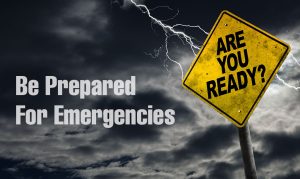
Personal preparedness includes being ready for emergencies at home, in your car, or anywhere else you may spend time. These preparedness efforts are a team effort. We are hopeful that the information and resources we provide help you and your family to be better prepared for any future emergencies or disasters.
Being prepared can reduce fear, anxiety, and losses that accompany disasters. What you do now can help you and your family better respond to and recover from any disaster or emergency, as well as contribute to the overall readiness of your community. Although there are many things that people can do to increase their preparedness for emergencies, the areas/items listed below are a good start that cover the most important items during a disaster/emergency event!
Click on the dropdown for each area of readiness! See graphics, download documents, visit links and/or watch informative videos in some of the tabs to learn more.
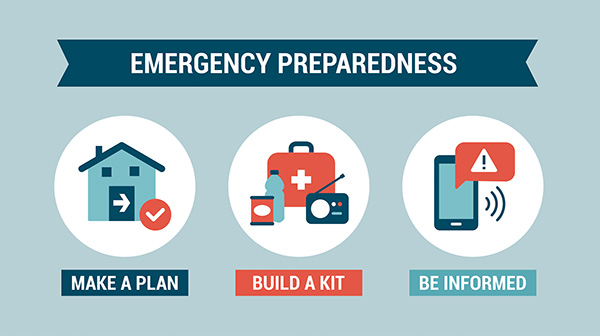
Make A Plan! Practice Your Plan!
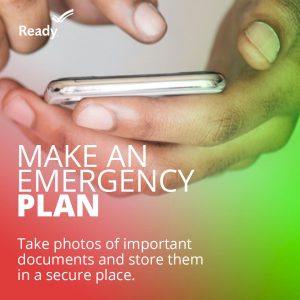
Make a Plan
Before any emergency happens, make a plan. To start, sit down as a family and create both an emergency plan as well as a communications plan. Make sure everyone has each other’s phone numbers and also has numbers for other family or friends nearby who can help relay information.
Also decide on a good safe location you can all meet at if you are unable to return home right away. A friend, family member or local landmark (church, school, etc.)
Also consider creating a household Fire Escape Plan. Create the Plan and practice it with your household to help educate everyone on proper avenues of escape in the event of a fire and where everyone shall meet.
Finally, DO NOT forget about your pets!
Write down it all down (see useful, printable lists below) and make copies for everyone and keep a copy in your emergency supply kit. Remember to check the plan periodically to make sure its always up-to-date. And do not forget to create a plan and gather supplies for your family’s four-legged members.
-
-
- Family Communications Plan
- Family Emergency Plan (wallet size cards)
-
Practice Your Family’s Emergency Plan
Preparing your family for a disaster involves more than just creating a plan. Each family member – especially children – should know exactly what to do during an emergency. Here are some helpful suggestions to communicate the importance of disaster preparedness to your family.
-
-
- Designate Roles / Responsibilities: Give everyone in your family a responsibility. Each family member is an integral part of the plan and each has an important contribution.
- Role-play: Younger family members may be easily upset if they see a parent worried or panicking. Spend an afternoon pretending an emergency has occured and allow everyone to practice their designated roles. This will help your family be better prepared for the rush of emotions they may experience during a disaster.
- Visit Emergency Meeting Places: If you have chosen an emergency meeting place, make certain your family is familiar with the location. Assist family members in recognizing landmarks (i.e., buildings, signs, curiously shaped trees or other landmarks, etc.) to help remind them of where they are or where they should be going. Ensure family members memorize emergency rendezvous location addresses.
- Introduce Your Family to Emergency Contacts: Young children may not be comfortable talking with strangers – even strangers their parents have designated as safe. Introduce your children to emergency contacts and explain their role in your family’s disaster plan. Instruct children regarding safe authority figures, such as firemen, police officers, emergency medical personnel, etc.
- Practice: Regularly quiz family members about the family’s emergency preparedness plan. Make it a game for younger children. Who’s our local emergency contact? Where do we go when there’s an emergency? Who’s responsible for watching the dog? What is our address? What are the phone numbers you will call? What will you do if we get separated? Where is the emergency kit stored and what is in it? Where is the water stored? How do you use a manual can opener? How do you use a cell phone or landline? The more the family practices the plan, the better family members will be able to recall what to do during an actual emergency.
- Point Out Emergency Essentials: Be sure everybody in your family know the location of your Disaster Supply / Emergency Kit. Keep your Disaster Supply / Emergency Kit in one place – if you move it, let everyone know the new storage location.
- Be Honest: Everyone in your family will have questions about preparedness. Take the time to address questions, concerns, and fears, honestly and factually. Discuss mental health concerns, evacuation, sheltering, and returning home. Emphasize, although the situation may be difficult, and there may be loss and/or sadness, the family has made and practiced the plans to survive and recover from any disaster situation.
-
Build Emergency Supply Kits!
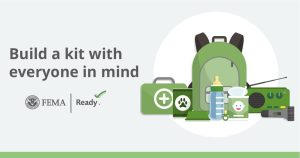
Make a Kit
You may need to survive on your own after an emergency. This means having your own food, water, and other supplies in sufficient quantity to last for at least 3 days.
Utilize the checklists below to help provide the information and items you need to create your own kits for your home, vehicle, pets, etc.:
Be Financially Prepared!
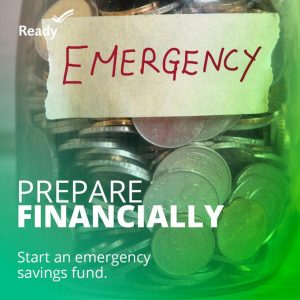
Americans at all income levels have experienced the challenges of rebuilding their lives after a disaster or other emergency. In these stressful times, having access to personal financial, insurance, medical and other records is crucial for starting the recovery process quickly and efficiently. Financial Preparedness
- Gather financial and critical personal, household and medical information.
- Consider saving money in an emergency savings account that could be used in any crisis. Keep a small amount of cash at home in a safe place. It is important to have small bills on hand because ATMs and credit cards may not work during a disaster when you need to purchase necessary supplies, fuel or food.
- Obtain property (homeowners or renters), health and life insurance if you do not have them. Not all insurance policies are the same. Review your policy to make sure the amount and types of coverage you have meets the requirements for all possible hazards. Homeowners insurance does not typically cover flooding, so you may need to purchase flood insurance from the National Flood Insurance Program.
- For more helpful financial preparedness tips, download the Emergency Financial First Aid Kit (EFFAK) to get started planning today.
Be Safe
- Be cautious about sharing personal financial information, such as your bank account number, social security number, or credit card number.
- Do not click on links in texts or emails from people you don’t know. Scammers can create fake links to websites.
- Remember that the government will not call or text you about owing money or receiving economic impact payments.
- Be aware that scammers may try to contact you via social media. The government will not contact you through social media about owing money or receiving payments.
- Keep in mind that scammers may try to take advantages of financial fears by calling with work-from-opportunities, debt consolidation offers, and student loan repayment plans.
- Contact the Federal Trade Commission (FTC) at ftc.gov/complaint if you receive messages from anyone claiming to be a government agent.
Emergency Financial First Aid Kit
The Emergency Financial First Aid Kit (EFFAK), a joint publication from Operation HOPE and FEMA, can help you prepare financially and provides tips to reduce the financial impact of disasters on you and your family.
At Home
Store important documents either in a safety deposit box, an external drive or on the cloud to make it easy to access during a disaster.
Take time now to safeguard these critical documents. Be cautious about sharing personal financial information, such as your bank account number, social security number, or credit card number.
Household Identification
- Photo ID (to prove identity of household members)
- Birth certificate (to maintain or re-establish contact with family members)
- Social Security card (to apply for FEMA disaster assistance)
- Military service
- Pet ID tags
Financial and Legal Documentation
- Housing payments (to identify financial records and obligations)
- Some individuals and households may experience financial difficulty because of the pandemic. If you do not think you can pay your loan payments on time, immediately contact your bank and discuss your options before skipping any payments or taking any other actions contrary to the terms of your loans.
- Insurance policies (to re-establish financial accounts)
- Sources of income (to maintain payments and credit)
- Tax statements (to provide contact information for financial and legal providers and to apply for FEMA disaster assistance)
Medical Information
- Physician information (in case medical care is needed)
- Copies of health insurance information (to make sure existing care continues uninterrupted)
- Immunization records
- Medications
Insurance Information
Having insurance for your home or business property is the best way to make sure you will have the necessary financial resources to help you repair, rebuild or replace whatever is damaged. Document and insure your property now.
Household Contact Information
- Banking institutions
- Insurance agents
- Health professionals
- Service providers
- Place of worship
Get Your Benefits Electronically
A disaster can disrupt mail service for days or weeks. If you depend on Social Security or other regular benefits, switching to electronic payments is a simple, significant way to protect yourself financially before disaster strikes. It also eliminates the risk of stolen checks. The U.S. Department of the Treasury recommends two safer ways to get federal benefits:
- Direct deposit to a checking or savings account. If you get federal benefits you can sign up by calling 800-333-1795 or sign up online.
- The Direct Express® prepaid debit card is designed as a safe and easy alternative to paper.
Apply for government-funded unemployment, healthcare, and food and nutrition benefits to supplement your income or savings.
Consider using online and mobile banking services, if you are able. These services enable you to practice social distancing and conduct banking transactions at the same time.
Prepare Your Pets!

Your pets are an important member of your family, so they need to be included in your family’s emergency plan. To prepare for the unexpected follow these tips with your pets in mind:
- Make a plan.
- Build an emergency kit.
- Stay informed.
Make a Plan
If you have a plan in place for you and your pets, you will likely encounter less difficulty, stress and worry when you need to make a decision during an emergency. If local officials ask you to evacuate, that means your pet should evacuate too. If you leave your pets behind, they may end up lost, injured or worse.
- Have an evacuation plan for your pet. Many public shelters and hotels do not allow pets inside. Know a safe place where you can take your pets before disasters and emergencies happen.
- Develop a buddy system. Plan with neighbors, friends or relatives to make sure that someone is available to care for or evacuate your pets if you are unable to do so.
- Have your pet microchipped. Make sure to keep your address and phone number up-to-date and include contact information for an emergency contact outside of your immediate area.
- Contact your local emergency management office, animal shelter or animal control office to get additional advice and information if you’re unsure how to care for your pet in case of an emergency.
- Preparing Pets for an Emergency
Build a Kit for Your Pet
Just as you do with your family’s emergency supply kit, think first about the basics for survival, such as food and water. Have two kits, one larger kit if you are sheltering in place and one lightweight version for if you need to evacuate. Review your kits regularly to ensure that their contents, especially foods and medicines, are fresh. Find Pet Preparedness List under the “Build Emergency Supply Kits!” tab.
Prepare Pets for Travel
When evacuating your home, it’s important to bring your pets. Because you may need to put your cat or dog into a pet carrier, it’s important that they’re comfortable with the experience. Follow these tips to reduce their stress:
- Leave the carrier out in places your pet frequently visits
- Leave the carrier open
- Feed them treats near the carrier – you can even try putting a few treats inside the carrier
- Add a favorite blanket or small bed inside the carrier so it smells familiar
- Make note of where your pets hide, so you can easily find them in case you have to leave your house quickly.
Create A Fire Escape Plan! Practice Your Plan!
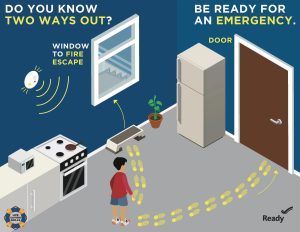
Creating and practicing a home fire escape plan is simple. Follow the steps below to make sure everyone in your home is prepared and knows what to do in case of a home fire.
- Make a written home fire escape plan and practice getting out in under 2 minutes.
- Make sure you have smoke alarms on every level of your home and in each bedroom. Test them twice a year.
- Learn the best practices for home fire safety and fire safety with children.
Make an Escape Plan
- Learn two ways out of every room in your home, in case one exit is blocked or dangerous to use. A second way out can include an escape ladder for rooms on an upper level.
- Practice getting low and moving to your exits in case there is smoke.
- Choose a safe meeting place a safe distance from your home.
- Have a home fire drill at least twice a year.
Children and Fire Safety
It is important to have a plan when there are children in your home. Children may become very scared and need clear direction and help getting out of the house. They may not know how to escape or what to do unless an adult shows them.
- Have a plan for young children under six who cannot get outside by themselves. In your plan, talk about who will help each child get out safely.
- Children should know what to do when they hear a smoke alarm and there is no adult around. Help them practice going to the outside meeting place.
- Teach children to NEVER go back inside a burning building. Once they are out, stay out!
- Teach your child to get low and crawl on the ground, where the air is less smoky.
- Show a child how to use the back of their hand to check doors for heat before opening and to use a different way out if the door is hot.
- If your child needs to use an escape ladder, show them where you keep it and practice how to use it.
Conduct a Home Fire Drill
Fires can start anywhere in the home and at any time, so run through the plan at different times of the day or night and practice different ways out.
Step 1: Know where to go. Review your safe meeting place. Explain to your kids that when the smoke alarm beeps, they need to get out of the house quickly and meet at that safety spot.
Step 2: Check your smoke alarms. Test your smoke alarms with your kids so they know the sound.
Step 3: Do the drill. Have kids head to their bedrooms and wait for the drill to begin. Assign adults to help young children. Put one adult in charge of sounding the smoke alarm and running the drill. Next, sound the smoke alarm, start the timer and have everyone book it to the safety spot. Once everyone gets to the safe meeting place stop the timer. If you all made it in under two minutes, you each get an imaginary gold medal. If not, give it another try. In a real fire, get to the safe meeting place, then call 9-1-1 and keep everyone close until firefighters arrive.
Interested in learning more, or finding fun and interactive preparedness activities for children, or possibly create an even more prominent family emergency plan? Feel free to visit some of these following websites for more.